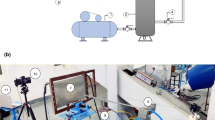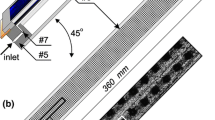Abstract
In this study, a two-dimensional inverse algorithm is developed to determine the heat transfer coefficient distribution of a two-phase air–water bubbly jet impinging on a steel cylindrical thermal mass. All procedures of thermal mass heating and cooling are simulated by solving two-dimensional, transient heat conduction equations using finite difference method. Afterward, the nonlinear inverse heat conduction problem is implemented to directly predict the local convective heat transfer coefficient of the bubbly jet. The sum of squared differences between calculated and measured temperature data is the objective function. Conjugate gradient method is employed sequentially in every time step to optimize the objective function at four gas Reynolds numbers which represent four different two-phase jets. The inverse scheme is validated using exact temperature data without noise. Local heat transfer coefficients are then estimated by inverse technique at five data acquisition times and four initial temperatures of thermal mass in the presence of noise. Furthermore, the effects of uncertainties due to indefinite lateral boundary conditions, temperature dependency of thermal conductivity, and the non-uniformity of the initial temperature distribution are investigated. A satisfactory agreement between exact and estimated heat transfer coefficients is achieved. However, the results show a greater sensitivity to the highest value of initial temperature, the shortest data acquisition time, and the lowest gas Reynolds number allowing a better estimation of heat transfer distribution for the bubbly jet.

















Similar content being viewed by others
Abbreviations
- CGM:
-
Conjugate gradient method
- \(C_{\rm P}\) :
-
Heat capacity (J kg−1 K−1)
- \(d\) :
-
Nozzle tube diameter (m)
- D :
-
Thermal mass diameter (m)
- DAT:
-
Data acquisition time (s)
- E :
-
Error
- \(h\) :
-
Heat transfer coefficient (W m−2 K−1)
- \(H\) :
-
Nozzle-to-target spacing (m)
- \(H_{\rm h}\) :
-
Heater thickness (m)
- \(H_{_{\rm ins}}\) :
-
Insulation thickness (m)
- \(H_{\rm s}\) :
-
Steel thermal mass thickness (m)
- IHCP:
-
Inverse heat conduction problem
- \(k\) :
-
Thermal conductivity (W m−1 K)
- \(Nu\) :
-
Nusselt number (hd/kL)
- \(q^{\prime\prime}\) :
-
Heat flux (W m−2)
- \(r\) :
-
Radial distance from stagnation point (m)
- \(Re\) :
-
Reynolds number (ρvd/µ)
- S:
-
Sensor
- \(S\) :
-
Sum of squared errors (K2)
- \(\vec{S}\) :
-
Search direction
- \(t\) :
-
Time (s)
- \(T\) :
-
Temperature (K)
- \(T_{\rm i}\) :
-
Initial temperature (K)
- \(T_{\infty }\) :
-
Surrounding temperature (K)
- \(Y\) :
-
Measured temperature (K)
- \(z\) :
-
Vertical distance from stagnation point (m)
- \(Z\) :
-
Sensitivity coefficient (m2 K2 W−1)
- b:
-
Bottom
- e:
-
End
- f:
-
Final
- G:
-
Gas
- i:
-
Number of iterations
- ins:
-
Insulation
- j:
-
Jet
- L:
-
Liquid
- meas:
-
Measured
- p:
-
Peripheral
- rms:
-
Root mean square
- s:
-
Steel
- t:
-
Top
- \(\alpha\) :
-
Thermal diffusivity (m2 s−1)
- \(\gamma\) :
-
Conjugate coefficient
- \(\lambda\) :
-
Step size
- \({\rho }\) :
-
Density (kg m−3)
- \(\sigma\) :
-
Standard deviation
References
Jambunathan K, Lai E, Moss MA, Button BL. A review of heat transfer data for single circular jet impingement. Int J Heat Fluid Flow. 1992;13(2):106–15.
Livingood JN, Hrycak P. Impingement heat transfer from turbulent air jets to flat plates: a literature survey. NASA Tech. Note; 1973
Webb BW, Ma CF. Single-phase liquid jet impingement heat transfer. Adv Heat Transf. 1995;26:105–217.
Agrawal C. Surface quenching by jet impingement: a review. Steel Res Int. 2019;90(1):1800285.
Zumbrunnen DA, Balasubramanian M. Convective heat transfer enhancement due to gas injection into an impinging liquid jet. J Heat Transf. 1995;117(4):1011–7.
Kakumoto T, Tomemori H, Horiki S, Osakabe M. Cooling characteristics of two-phase impinging jets, vol. 369. New York: ASME-PUBLICATIONS-HTD; 2001. p. 167–78.
Choo K, Kim SJ. Heat transfer and fluid flow characteristics of two-phase impinging jets. Int J Heat Mass Transf. 2010;53(25–26):5692–9.
Trainer D, Kim J, Kim SJ. Heat transfer and flow characteristics of air-assisted impinging water jets. Int J Heat Mass Transf. 2013;64:501–13.
Agrawal C, Lyons OF, Kumar R, Gupta A, Murray DB. Rewetting of a hot horizontal surface through mist jet impingement cooling. Int J Heat Mass Transf. 2013;58(1–2):188–96.
Friedrich BK, Glaspell AW, Choo K. The effect of volumetric quality on heat transfer and fluid flow characteristics of air-assistant jet impingement. Int J Heat Mass Transf. 2016;101:261–6.
Mohaghegh MR, Rahimi AB. Single-and two-phase water jet impingement heat transfer on a hot moving surface. J Therm Anal Calorim. 2019;12:1–1.
Hadamard J, Morse PM. Lectures on Cauchy’s problem in linear partial differential equations. Phys Today. 1953;6:18.
Tikhonov AN. Solution of incorrectly formulated problems and the regularization method. Sov Math. 1963;4:1035–8.
Tikhonov AN. Inverse problems in heat conduction. J Eng Phys Thermophys. 1975;29(1):816–20.
Alifanov OM. Solution of an inverse problem of heat conduction by iteration methods. J Eng Phys Thermophys. 1974;26(4):471–6.
Alifanov OM. Inverse heat transfer problems. Berlin: Springer; 2012.
Beck JV, Blackwell B, Clair CR Jr. Inverse heat conduction: Ill-posed problems. Fairfield: James Beck; 1985.
Hestsenes MR, Stiefel E. Methods of conjugate gradients for solving linear equations. J Res Natl Bur Stand. 1952;49:409–36.
Fletcher R, Reeves CM. Function minimization by conjugate gradients. Comput J. 1964;7(2):149–54.
Huang CH, Özisik MN. Inverse problem of determining unknown wall heat flux in laminar flow through a parallel plate duct. Numer Heat Transf. 1992;21(1):55–70.
Huang CH, Chen WC. A three-dimensional inverse forced convection problem in estimating surface heat flux by conjugate gradient method. Int J Heat Mass Transf. 2000;43(17):3171–81.
Colaco MJ, Orlande HR. Inverse forced convection problem of simultaneous estimation of two boundary heat fluxes in irregularly shaped channels. Numer Heat Transf Part A Appl. 2001;39(7):737–60.
Ozisik MN, Orlande RBH. Inverse heat transfer. Boca Raton: Taylor and Francis; 2000.
Taler J, Duda P. Solving direct and inverse heat conduction problems. Berlin: Springer; 2010.
Anderson BA, Singh RP. Effective heat transfer coefficient measurement during air impingement thawing using an inverse method. Int J Refrig. 2006;29(2):281–93.
Sagheby SH, Kowsary F. Experimental design and methodology for estimation of local heat transfer coefficient in jet impingement using transient inverse heat conduction problem. Exp Heat Transf. 2009;22(4):300–15.
Mobtil M, Bougeard D, Solliec C. Inverse determination of convective heat transfer between an impinging jet and a continuously moving flat surface. Int J Heat Fluid Flow. 2014;50:83–94.
Forouzanmehr M, Shariatmadar H, Kowsary F, Ashjaee M. Achieving heat flux uniformity using an optimal arrangement of impinging jet arrays. J Heat Transf. 2015;137(6):061002.
Farahani SD, Bijarchi MA, Kowsary F, Ashjaee M. Optimization arrangement of two pulsating impingement slot jets for achieving heat transfer coefficient uniformity. J Heat Transf. 2016;138(10):102001.
Liu T, Montefort J, Stanfield S, Palluconi S, Crafton J, Cai Z. Analytical inverse heat transfer method for temperature-sensitive-coating measurement on a finite base. Int J Heat Mass Transf. 2018;118:651–62.
Bergman TL, Incropera FP, Lavine AS, DeWitt DP. Introduction to heat transfer. Hoboken: Wiley; 2011.
Touloukian YS, Powell RW, Ho CY, Klemens PG. Thermophysical properties of matter-the TPRC data series. Volume 1. Thermal conductivity-metallic elements and alloys. Thermophysical and electronic properties information analysis Center Lafayette In; 1970.
Author information
Authors and Affiliations
Corresponding author
Additional information
Publisher's Note
Springer Nature remains neutral with regard to jurisdictional claims in published maps and institutional affiliations.
Rights and permissions
About this article
Cite this article
Kowsary, F., Razzaghi, H. & Ashjaee, M. Experimental design for estimation of the distribution of the convective heat transfer coefficient for a bubbly impinging jet. J Therm Anal Calorim 140, 439–456 (2020). https://doi.org/10.1007/s10973-019-08819-z
Received:
Accepted:
Published:
Issue Date:
DOI: https://doi.org/10.1007/s10973-019-08819-z




